25+Ways to Use Fruit Powders
Have you discovered a fantastic way to dehydrate fruit and make fruit powders? But are you confused about how to use it? Here are ways to use fruit powder to give your dehydrated fruit a second life!
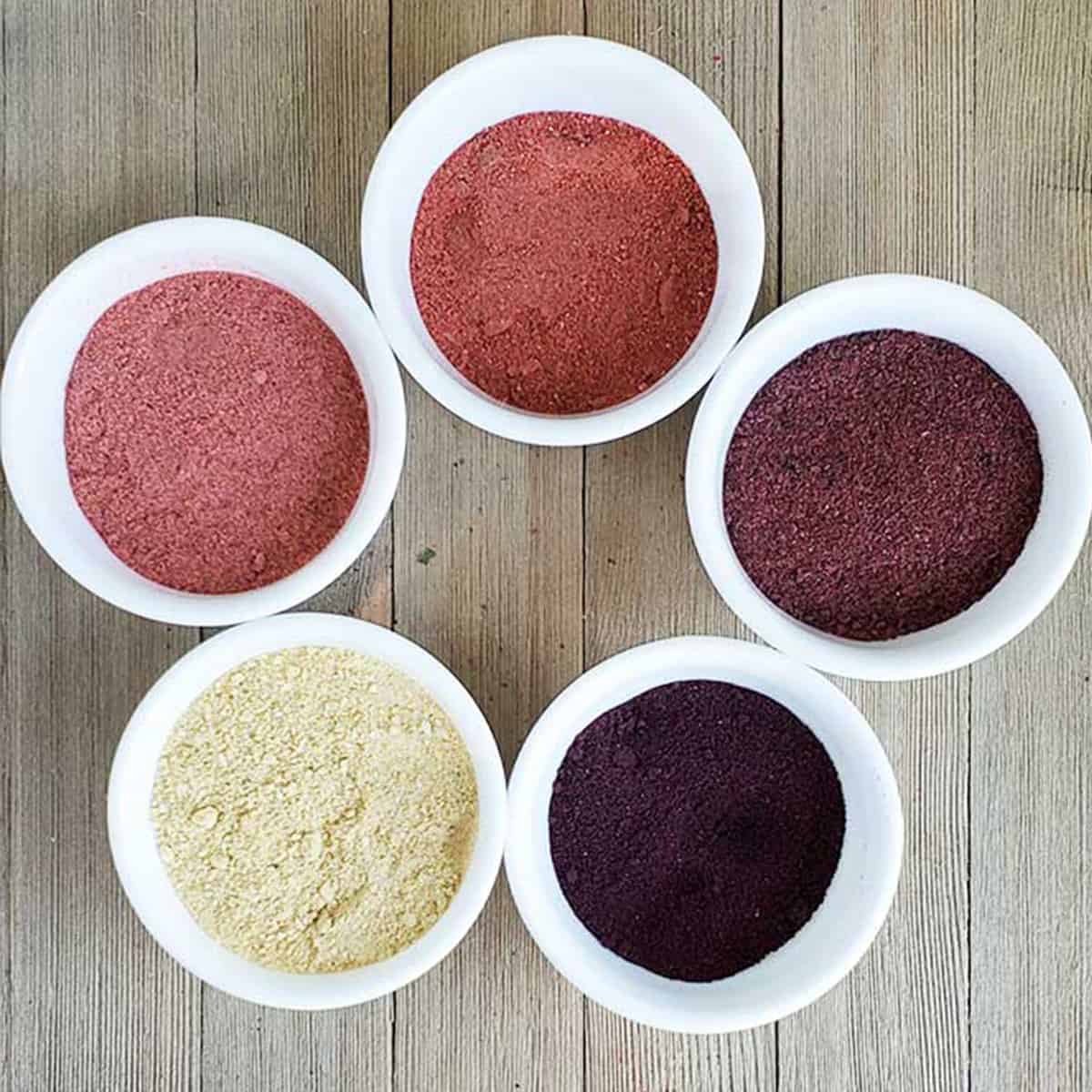
Have you ever had a dehydrating project not go quite the way you’d hoped or found that you might not have liked the texture? Or maybe you’ve created fruit chips instead of fruit leather and don’t want to throw them away?
After discovering how easy it is to make and use dehydrated fruit powders, I threw those dried blackberries into my blender and fell in love. Blackberry yogurt made with blackberry powder is now a staple in our breakfast menu.
So don’t waste a dehydrating project simply because you didn’t like the outcome. Give the dehydrated fruit a new life by making it a versatile fruit powder!
How to Make Fruit Powders
Just in case you’ve never experienced the magic of creating fruit powder from dehydrated fruit or fruit leathers, here’s how to do it:
- Dry your fruit completely – usually at 135°F / 52°C using your dehydrator. You can use an oven to dry fruit with these tips if you don’t own one. And remember, drier is always better, especially when making powders, no matter what drying method you choose.
- Use a high-powered blender, a bullet-type blender, or even a coffee grinder to blend into a powder. I’m really fond of the NutriNinja and the Cosori Coffee Grinder that I have switched to.
- Sift powder with a fine mesh strainer if you have lumps and seeds.
- Repeat if necessary.
- Condition powder in the oven. Place powder on a cookie sheet in a warmed (but off) oven for 15 minutes. This helps remove any residual moisture coming from the grinding process and being out in the open air. You can learn more from this instructional post on how to stop powders from clumping.
- Store in an airtight container, use desiccant packs if desired.
Here’s a trick!
If you want to skip the dehydrating fruit step – make a puree of your fruit, dry the puree until it breaks apart (not fruit leather, but fruit chips!) and then powder those chips.
LEARN MORE: How to Keep Powders from Clumping
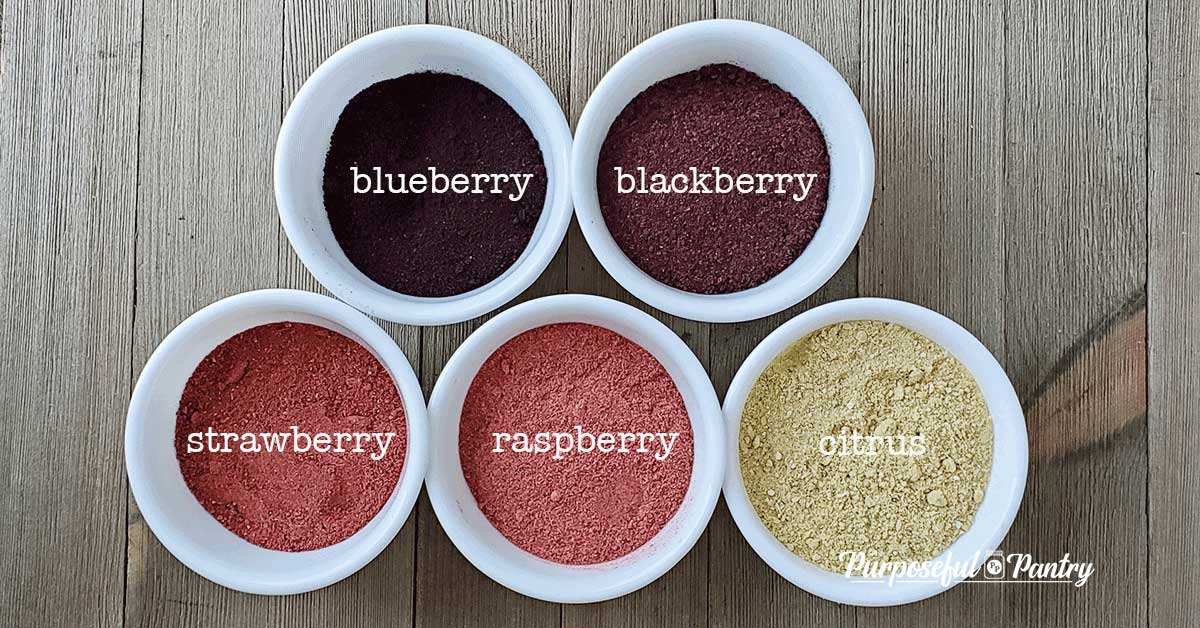
Additional Tips:
- If using fruit leather to make a powder, tear it into small pieces before starting the process
- Remember that fruit powder does have all the sugar that is in fruit. If you have a diet that requires restricted sugar intake, keep that in mind. The sugar (carbs) in 1 Cup of fresh fruit equals the sugar in 1 TB of fruit powder.
- Don’t have fruits in season to powder? Try powdering freeze-dried fruits, instead!
How to Use Fruit Powders
Fruit powders can be used in so many ways to extend flavor and nutrition to everyday foods. You can also elevate the look and style of things like cocktails, breads, etc..
Breakfast Meals
You can add the intensifying flavor of fruit powder to:
- Oatmeal: sprinkle on top of oatmeal. One of my favorites is apple powder. Added sweetness plus apple flavor with a dash of cinnamon!
- Yogurt: mix with plain yogurt for color change and added flavor.
- Flavored Milk: add to milk to change color and flavor. This doesn’t make super sweet milk your kids may be used to, but add a tiny dash of sugar to help out.
- Cereal: adding a little extra fruit powder to cereal can give a new flavor profile to your bland cereals.
- Granola – add fruit powder to create a new flavor profile. Apple cinnamon granola with added apple powder gives you a nice sweetness and an intense flavor. Add some coconut powder and dried mango to a granola mix for a tropical flavor.
Condiments
- Salad Dressing – mix into homemade salad dressings for a fruity twist on salads of all kinds.
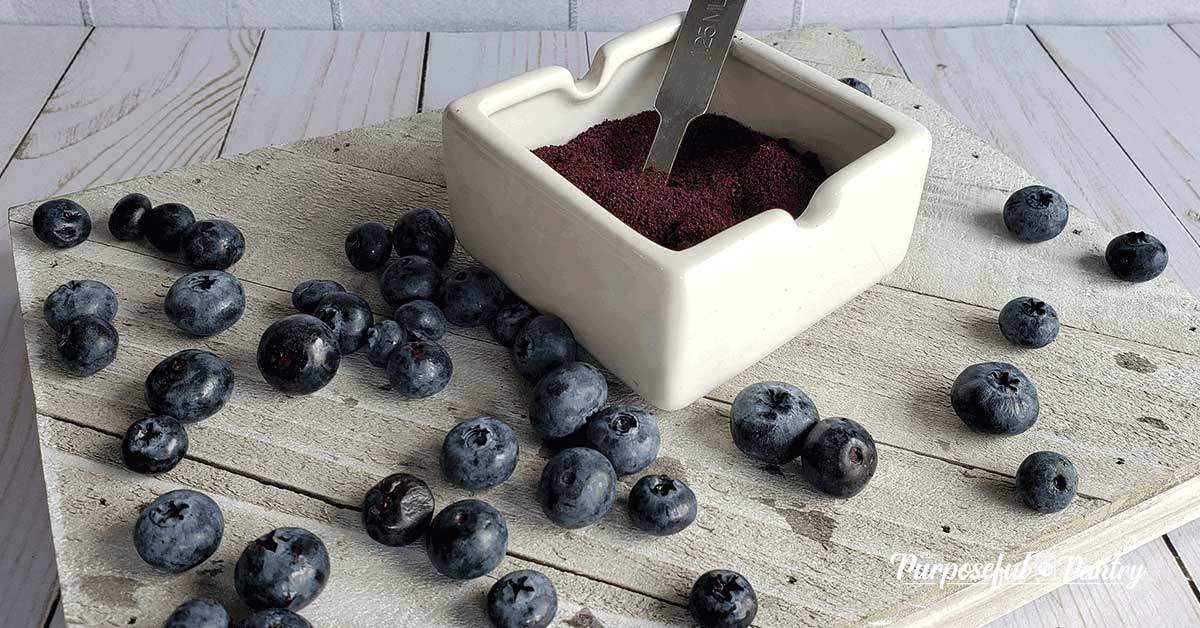
Breads and Batters
Make sure to experiment with the addition of powder to a baked item. You may need to add extra moisture as the powder will use some to hydrate itself.
- Quick Bread: add an extra burst of flavor to quick breads by including fruit powders instead of more bulk. Imagine the flavor intensity in banana bread by adding another tablespoon or two of banana powder!
- Pancakes: Not just for breakfast! Extend the nutrition of your favorite pancake recipe like dessert pancakes, crepes, waffles, etc. Add some extra fruit powder to flavor to your favorite taste!
- Muffins & Scones: As with quick breads, you can add an extra burst of flavor by adding to your favorite mixes to bring extra flavor without creating extra bulk. Imagine creating little blueberry muffins that were actually blue for a fun afternoon tea treat!
Helpful Tip: Do you want to know a secret? You can also add vegetable powder to your breads and batters; no one will know that there are veggies in their muffins or pancakes! You can experiment with quantities by adding just a tablespoon to a recipe (which equals about 1 cup of fresh vegetables) and increase as you wish.
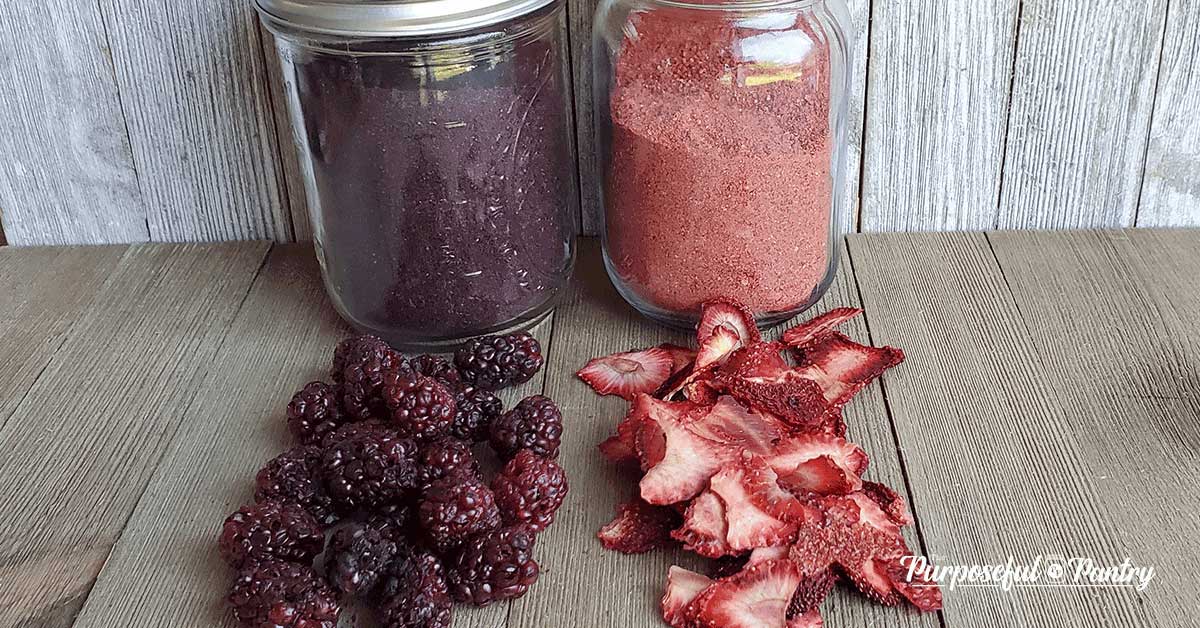
Snacks
- Granola Bars – when making granola bars or energy bites, add a little fruit powder to the mix, or sprinkle on top for some added flavor.
- Marshmallows – if you love making homemade marshmallows, use fruit powders to color and add flavor without adding extra fruit bulk. If you want to take a huge step up – dehydrate marshmallows, powder, and mix with a little fruit powder of your choice to add to hot chocolate or sprinkle on cupcakes.
- Crispy Rice treats – those marshmallowy, gooey treats can be elevated with the addition of fruit flavor to make YUMMY treats!
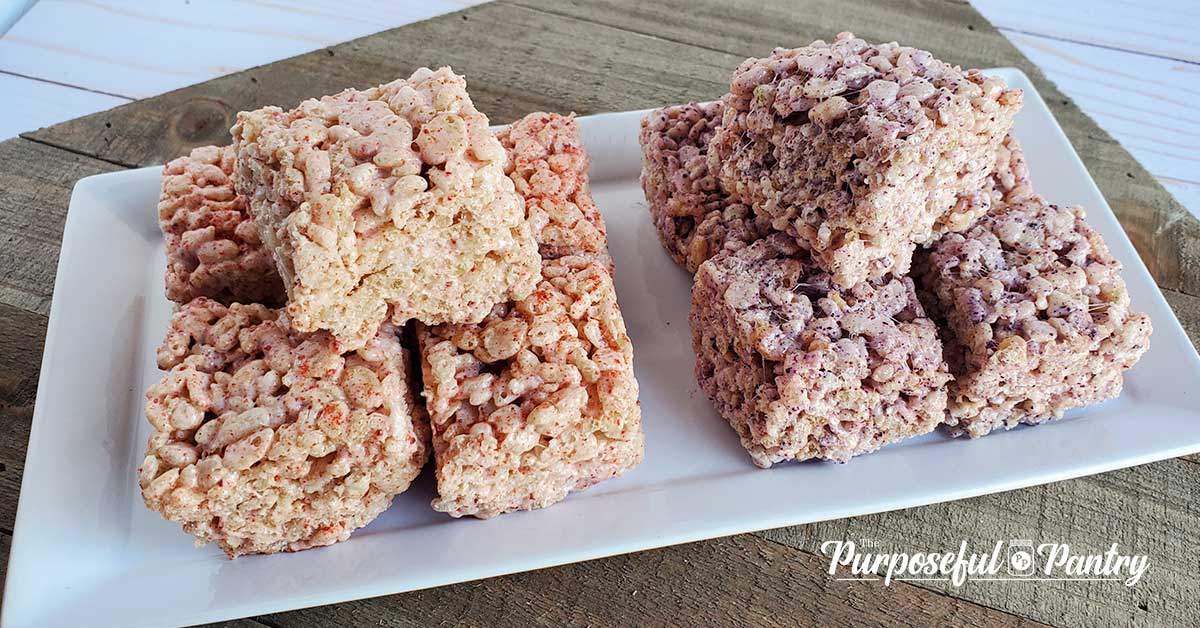
- Dehydrated Fruit Chips – sprinkle a companion flavor onto your favorite fruit chips to create new flavor profiles. What about a little blueberry powder sprinkled onto banana chips.
- Yogurt Drops – you can make your own flavored yogurt drops
- Add 1 tablespoon of fruit powder to 1 cup of favorite plain yogurt (you can adjust to your taste).
- Line dehydrator trays with reusable silicone sheets or parchment paper (baking paper)
- Pipe ‘dots’ onto dehydrator tray using parchment paper (baking paper) or reusable silicone sheets. You can use a zip-top bag if you don’t have piping sleeves.
- Dry at 135F / 57C for 8-12 hours until crispy. Time may vary due to the size of dots, the wattage of your machine, and relative humidity in your home.
- Store in an airtight container in the fridge for 2-3 weeks.
- Whipped Flavored Cream Cheese – Whip your own cream cheese by placing a block of softened cream cheese into a bowl and use your hand mixer or a stand mixer to whip air into it. Add fruit powder to taste and create a wonderful bagel topping or dolloped onto strawberry halves or as a spread on thinly sliced pound cake and topped with fruit for a dessert!
- Dipped pretzel rods — mix a little of your favorite fruit powder into some melted dipping chocolate. Dip pretzel rods, garnish, and place on wax paper to dry.
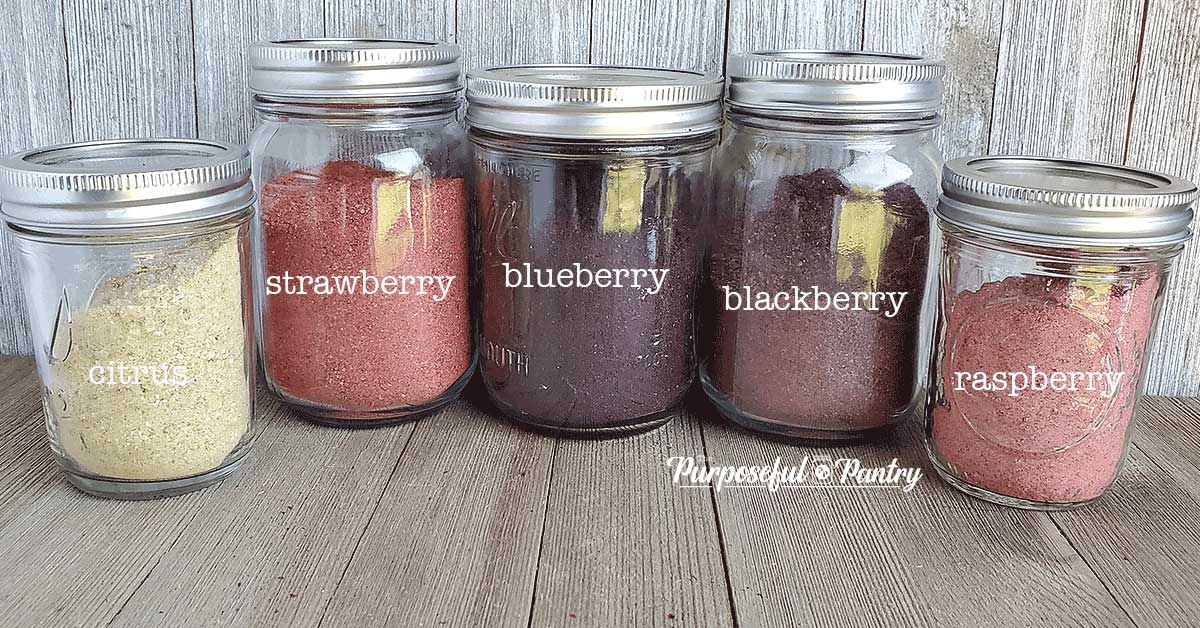
Desserts
Use fruit powders in these dessert items to not only change colors, but also give an intensity of flavor to them, as well.
- Ice Cream: top vanilla ice cream with any flavor of fruit powder to bring an extra kick
- Snow Cream – the perfect snow day activity with your kids!
- Fruit Sugars – you can blend fruit powder and sugar together to create a great dusting for the tops of muffins and cupcakes. This is similar to icing sugars, but a finder texture. Sweet + fruity + sparkly = YUM!
- Ice Cream – mix in with your favorite ice cream recipe to intensify the flavor
- Frosting/Icing – mix with frosting or icing to change both the flavor and the color
- Cake Batter – mix with cake batters to change color OR give an extra burst of flavor.
- Cookies – Adding a little strawberry fruit powder to a snickerdoodle will bring a surprise flavor!
- Fruit Pops – You can change the flavor while making fruit pops even if you don’t have the particular fruit available. So imagine making strawberry banana pops with strawberry fruit and some added banana powder!
- Pie – of course, making pumpkin pie with pumpkin powder is super easy when you have pumpkin already ready to go! It easily reconstitutes into a pumpkin puree with the addition of hot water. Simply mix:
- 2 C warm water
- 1/2 C pumpkin powder
- Allow to sit for 30 minutes. You can mix more or less to create your desired consistency.
- Pie – Yes, there are more pies than just pumpkin. Use fruit powder to help thicken a pie or add more intense flavor if your fruit is not quite ‘fruity’ enough.
- Whipped cream – if you make homemade whipped cream, imagine what it would taste like with just a little bit of mixed strawberry powder and then put in between strawberry shortcake layers.
The above photo is a sample conversion of fruit to dehydrated fruit to fruit powder – using dehydrated raspberries as an example.
Dry Rubs & Seasonings
Dry rubs and seasoning blends can elevate the flavor of your favorite meats or dishes. Consider a few of these for your next meal prep:
- Cherry or blackberry – make an excellent flavor for BBQ sauces for red meat
- Chile/Lime seasoning makes EVERYTHING taste better when done on the grill or added to zucchini or cucumber slices in the dehydrator for chips.
- 2 teaspoons chili powder
- 1 teaspoon garlic powder
- 1 teaspoon onion powder
- 1 teaspoon salt
- 1/4 teaspoon black pepper
- 2 tablespoons fresh lime powder
- Pineapple 5 Spice Dry Rub
- 1/4 cup brown sugar (learn how to make your own!)
- 2 tbsp pineapple skin powder
- 2 tbsp sesame seeds
- 1 tbsp ground ginger
- 1 tbsp salt
- 1 tbsp garlic powder
- 1 tbsp caramelized onion soup powder
- 1 tsp Chinese Five Spice Powder
- pinch red pepper flakes
- 1 tsp ground white pepper
Teas and Drinks
Remember that fruit powders don’t dissolve the way drink mixes do, so you will want to keep that in mind as you do drink mixes. They powder will certainly infuse your beverage, but it will leave fiber in your drink.
- Tea blends – make your own homemade tea blends with fruit powders for that hint of flavor and sweetness. You can even add it to your regular tea for an extra bit of fruit flavor. Using lemon powder can be a great way to have lemon-flavored tea even if you’re out of fresh lemons! If you want the flavor, but not the possible grit, use a tea infuser!
- Smoothies – use fruit powder in your morning smoothies instead of whole fruit if you’re not a fan of the textures (seeds, etc.) or want to intensify the flavor.
- Flavored Water – Just like using real fruits, you can put fruit powder into a tea bag or tea infuser and steep in your water for a flavor enhancer.
- Cocktails – Mix with a little sugar and use on the rim of a fruity adult drink. Do it with mocktails to make them feel a little extra special.
TIP: to get dissolvable fruit powder, you need to start with fruit juice.
How to Store Fruit Powders
Fruit powders are best kept in airtight containers. You may find clumping or caking an issue because of the sugar content of fruit powders compared to vegetable powders. You can use a desiccant pack to help remove any moisture and various methods such as arrowroot powder, reblending, or other methods to help with clumping. Apple and banana powders are especially susceptible; these tips may help you.
Fruit powders last about 6-9 months in most cases. You should consider storing the whole dried fruit for a longer shelf-life and powdering on demand (1-2 month supply) for the short term.
Watch me make Blueberry Fruit Powder.
This process translates to just about every fruit powder that you want to use.
Subscribe to my Youtube channel for even more great videos on dehydrating, canning, and food storage.
How Long Does Fruit Powder Last?
Fruit powders, like ground spices and herbs, don’t have as long of a shelf life as their whole counterparts. Six to nine months is the time given by the National Center for Home Food Preservation for powders.
Properly dried, conditioned, and stored fruit powder has a shelf life of up to a year. It lasts longer, but you can see a reduced quality, color, and perhaps even texture (clumping) over time. It is always best to keep dried fruit whole and grind for shorter-term use if possible.
Best Ways to Powder Fruit
The best machine to powder fruits is tall and narrow, like a blender, versus wide, like a food processor.
- Coffee Grinders – these are best for small amounts. I prefer one that has a removable cup because it makes clean-up so much easier, especially because fruit powders can cake the blades because of the sugar content. It’s so much easier to throw a cup into a soapy water sink or dishwasher than to try to clean an all-in-one grinder.
- Bullet blenders – perfect for mid-range capacities (1-3 cups of dried fruit, depending on the size of your blender cup. I also get a better powder because the shape and size of the cup force the fruit down into the blades better than a larger carafe.
- Blenders – great for large quantities, though you may find it necessary to strain and re-powder.
Pulsing is the best way to help this issue, instead of a continual mode. High speed, cyclonic blenders will work better than smaller motor machines but aren’t necessary. I used a Ninja blender for years before switching to my Nutri-Ninja earlier this year.
Fruit Powder Questions
As with any dehydrated foods, Vitamins A & C are lost with longer processes under the typical drying temperature of 135°F/57°C. You can dry at below 115°F/46°C to keep all the nutrients (but know you’ll lose those through cooking/baking if you use the powder that way.
Yes! These aren’t the same as using something like Athletic Greens and don’t dissolve as much as rehydrate, so they won’t just mix up in water. But they will work in smoothies great!
Final Thoughts
Dehydrating fruit is a wonderful way to preserve fruit for your pantry. It encourages less waste, gives you healthy afterschool snacks, and allows you to build a long-term storage pantry full of nutritional options.
But don’t settle just for dehydrated fruit. Experiment with some of the 25+ uses listed above and see how far you can take your next steps in making full use of your dehydrator and the food you preserve with it!
What are some of your favorite ways if you already use fruit powders? We’d love to learn more uses!
Want to learn more about dehydrating? Here’s The Ultimate Do Not Dehydrate List.

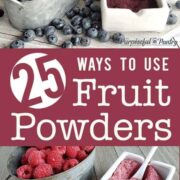
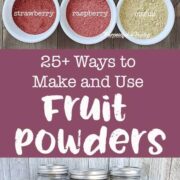
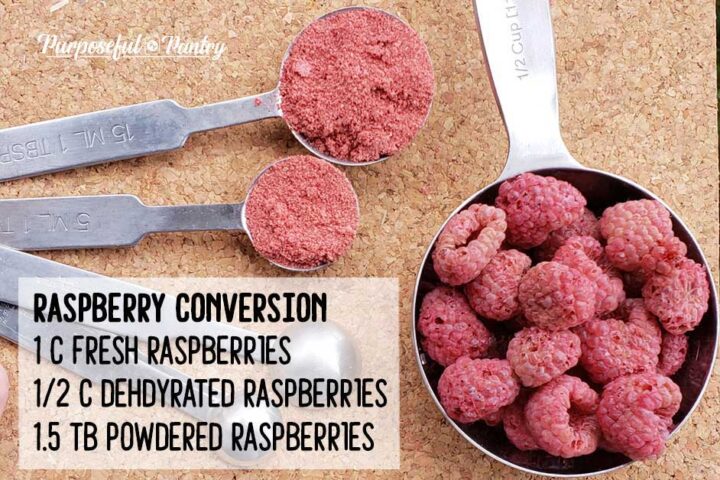
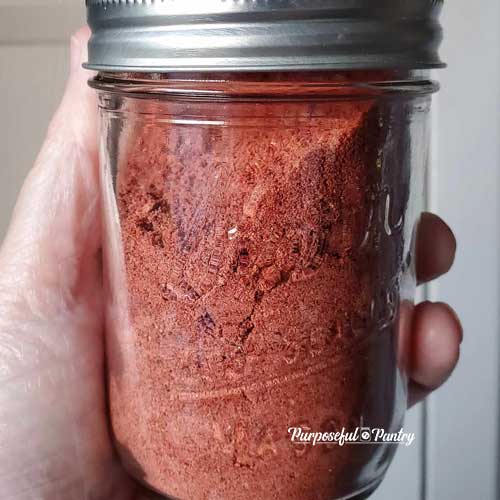
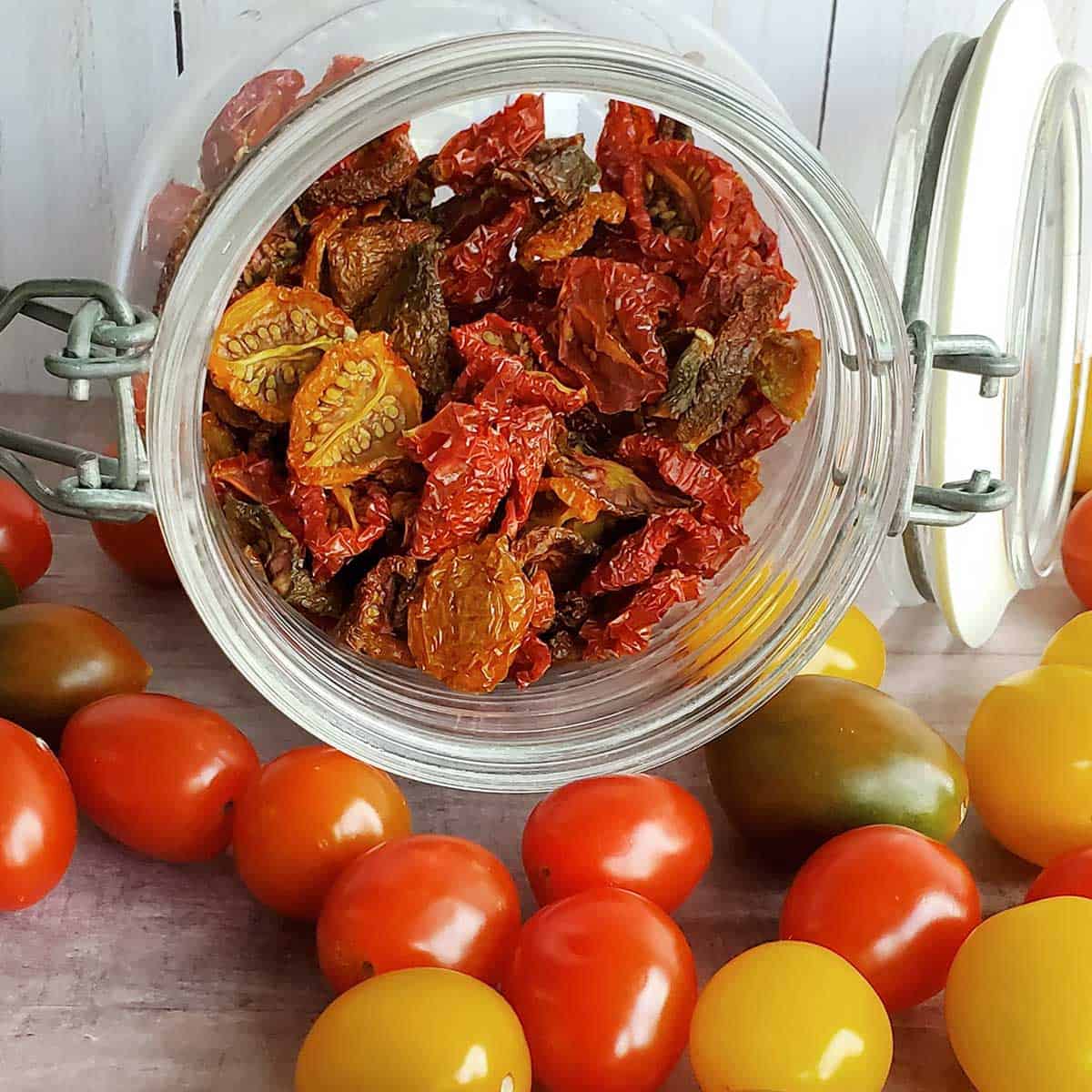
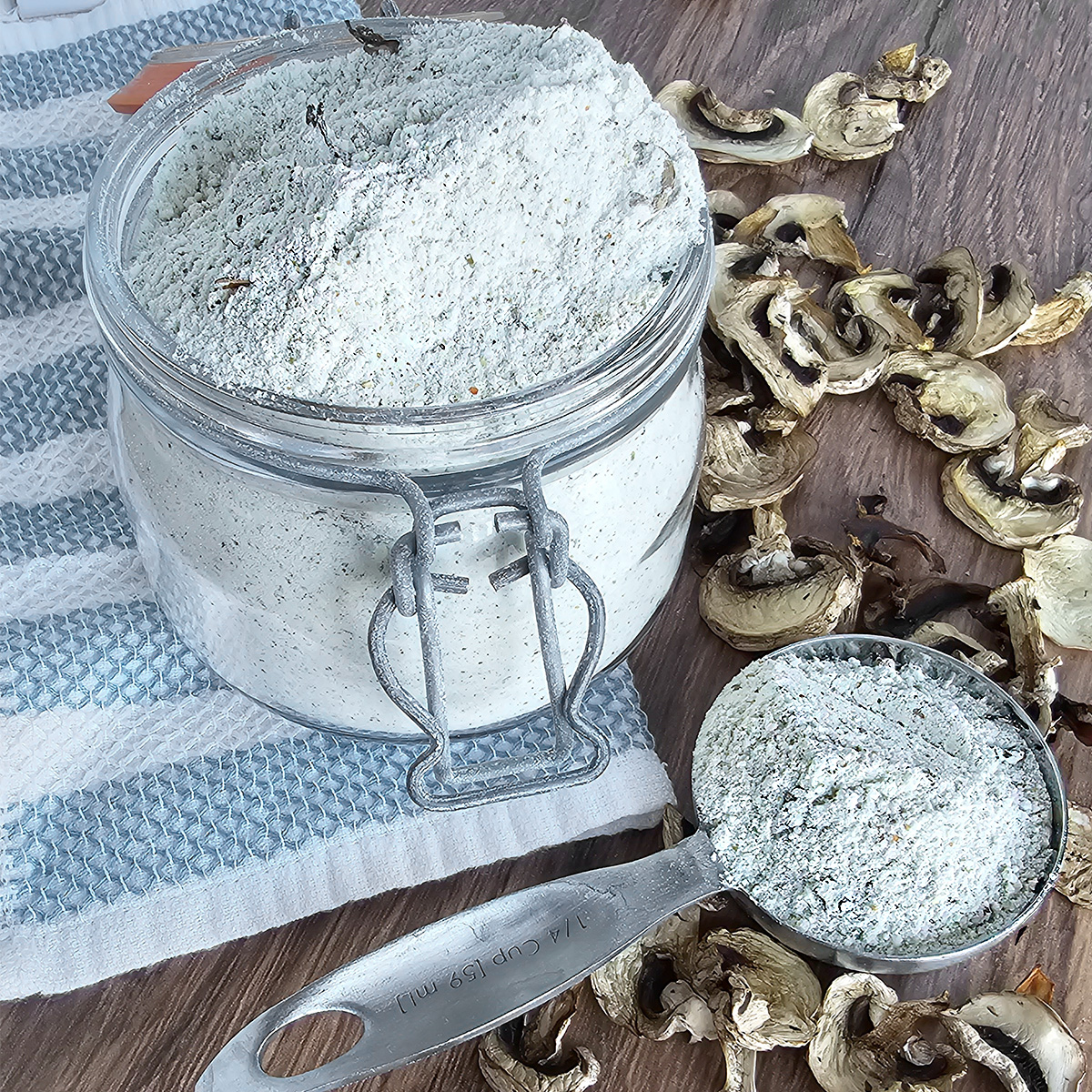
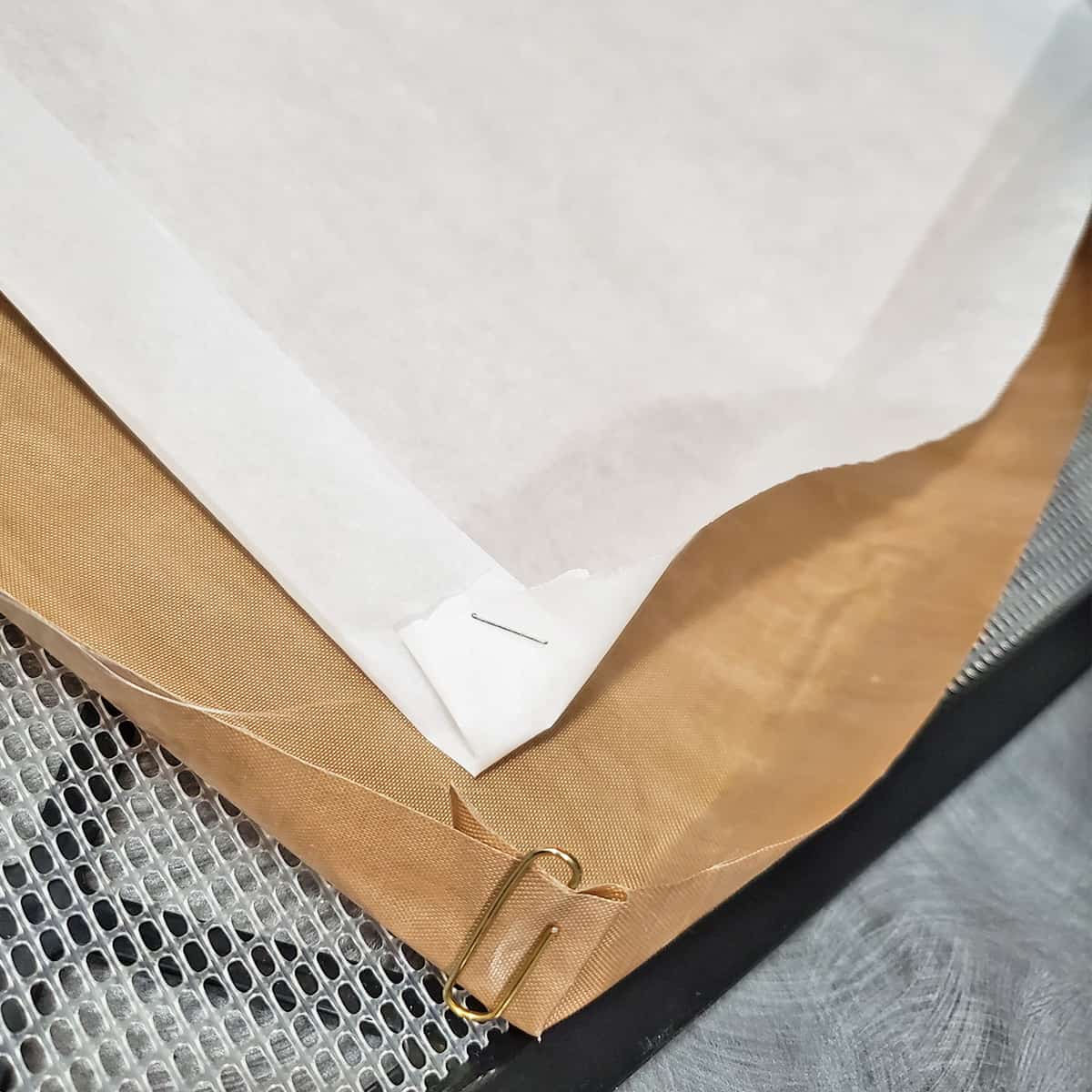

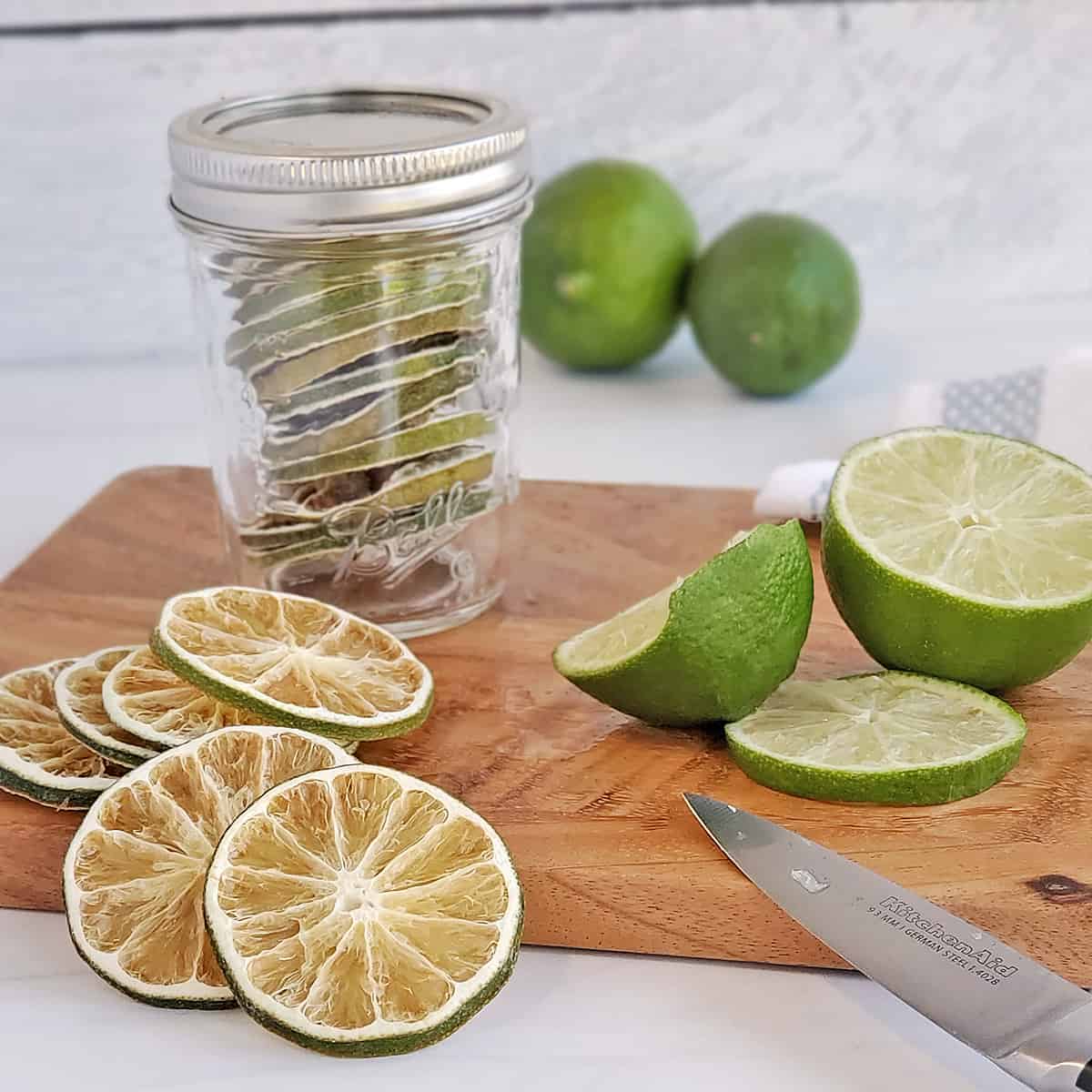
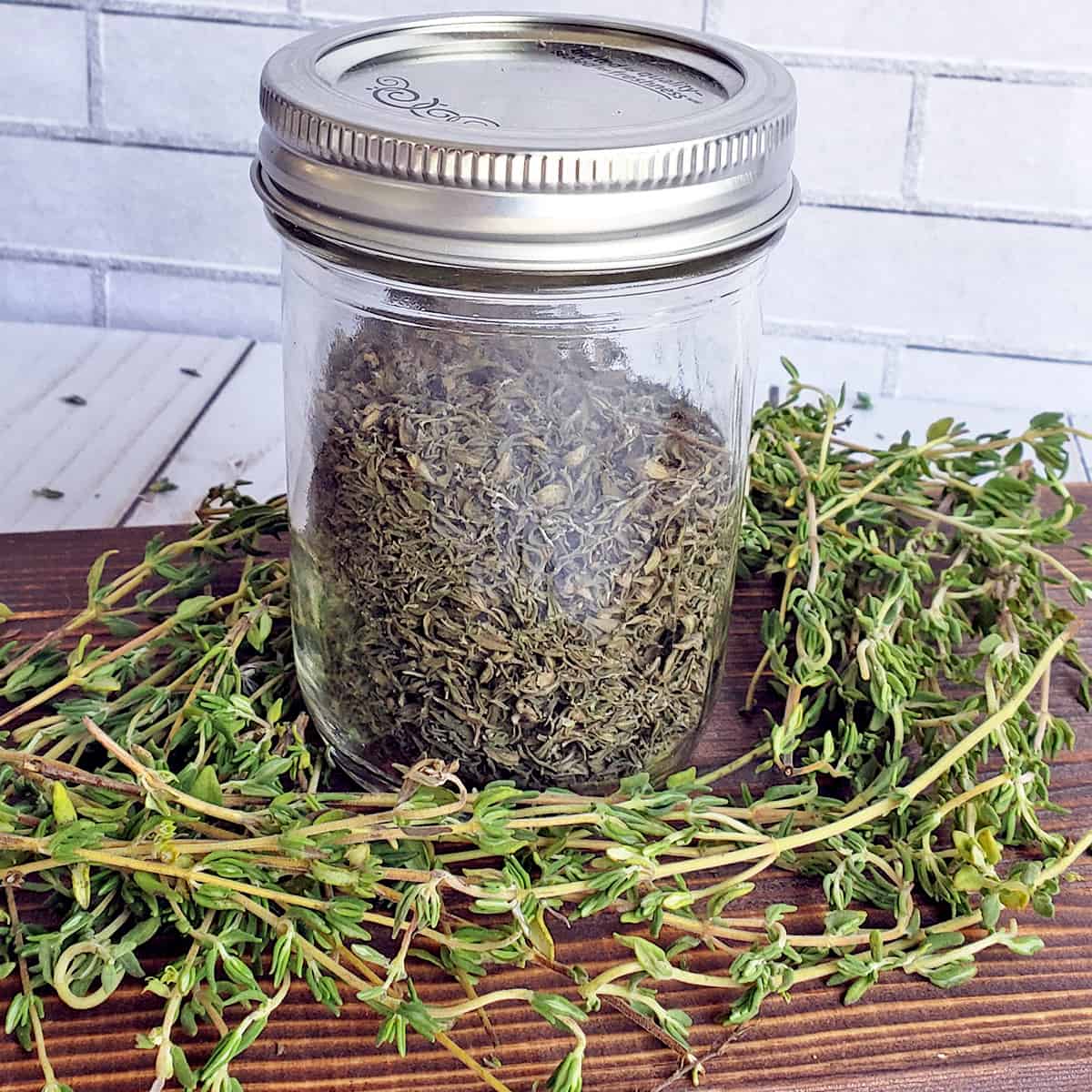
Wonder if you can dehydrate olives to mix with cream cheese?
https://www.thepurposefulpantry.com/dehydrate-olives/
Hii
Can I use fruit powder to flavor whipped/creamed honey?
You can, but it doesn’t dissolve, so you’ll have speckles 🙂 It will eventually rehydrate over time, but it’s not an immediate blend.
Have you ever tried making fruit powder with waitermelon? I wonder how that would come out.
No – the sugar content will make it hard to store. But dry it enough – to the point of it being almost brittle, and give it a try!
Wonder. Can i add the fruit powder to lip or cheer-make up on face ?
I’m not familiar enough to know which would work well, but powders that are vegetable derived have been used for centuries.
I don’t know if I just missed it or if the information was not mentioned. When you said to skip dehydrating make the fruit into a puree. Then you mentioned to dry it into fruit chips. But how do you dry it into chips?
You pour the puree onto your trays and dry it past the point of a fruit leather – dry it completely.
Will the fruit power (flavor) last longer if it is placed in small vacuum sealed packets. Would probably need to put in zip lock baggie first so as not to suck all the power out.
Now I am really looking forward to blueberry season.
Thank you!
You’ve broken down the powder so many times between dehydrating, cutting, powdering, etc., they aren’t meant for long-term storage. Just like spices, they just don’t have a long shelf-life, even if you seal them. Store them whole, and powder as much as you need for shorter time periods.
How long will these fruit powers last in a jar ? And can I just get some packs of dried fruit and then blend it until its powder ?
Directly from the article: Fruit powders last about 6-9 months in most cases. You should consider storing the whole dried fruit for a longer shelf-life and powdering on demand (1-2 month supply) for the short term.
Not in most cases as they are treated with things to keep them soft.
Question:
I have a very hard time consuming textures so your process of making fruit powders appeal to me. I have all the tools but my BIG question is, since I love fruit leather: can I reconstitute fruit powder, perhaps using a juice base, into a fruit leather to be re-dehydrated again on a silicone tray?
The problem may be integrating that fiber back into the liquid as it doesn’t dissolve. So it may be spotty, but give it time to rehydrate it and blend it, and it will work.
Hi Darcy, it has been quite a while since your information on fruit powders was posted, but I am just now seeing it and wanted to check in to say, ‘thank you’ bc it is such a great option and idea.
Ruth
I’m glad you found it helpful!
I never thought I needed a dehydrator but reading this really makes me want to get one. Thank you for the great tips! I am going to see what happens when I add some to my homemade chocolates…fingers crossed…
Good luck!
yum! That sounds good!
You have mentioned a couple of times that once powdered and then added back to water, the fruit powders will not dissolve and become a juice.
1.What has to be added to the powder and water to be reconstituted back into juice? Minimally, what has to be added to the powdered fruit and water to have a similar result to adding water to commercial drink mixes?
2. If your answer is an emulsifier, what are some natural emulsifiers that can be used?
I’ve not used emulsifiers to know how they work or what they do, but no matter what, you still have the actual fiber of the fruit – which is the powder. It will not dissolve from a dehydrated state, thus it ill always be a physical grit. It will help flavor a drink, but it will not be juice.
I have been adding fruit and vegetable powders to my ground meats and other recipes for 30 years now. This is a great idea for those with kids and spouses that don’t like veggies and fruits.
You show citrus powders in your photos, but there isn’t a link to dehydrating citrus fruits. Did you dry slices and powder the whole thing (including the white pith) or did you just do the zest and middles? How long and at what temp?
Thanks in advance
I have a lot of dehydrated products that I haven’t recorded for the blog – so yes, there is citrus there with no tutorial, yet. Your choice on doing the entire fruit, or only the zest and flesh. With the whole fruit, I don’t find the pith overpowering when it’s not thick. These lemons and limes weren’t – and worked well. But a big orange with a thick pith layer might need to be zested and then just the flesh sliced and dried.
BTW -temp is 125=135F and however long it takes.